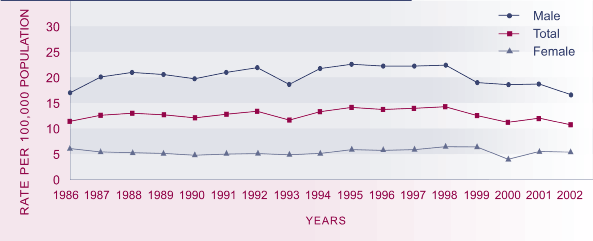Suicide
Definition
The number of suicide deaths per 100,000 population.
Relevance
Suicide is an indicator of the mental health and social wellbeing
of society and a major cause of injury-related death in the population.
Current level and trends
In 2002, 460 people died by suicide, a decline from 507 in 2001.18 The
age-standardised19 suicide death rate was 10.7 per 100,000 in 2002, compared
with 12.0 per 100,000 in 2001. Over the 1980s and 1990s there was an upward
trend in the suicide death rate, which reached a peak of 14.3 per 100,000 in
1998. Since then the rate has fallen by 25 percent and the 2002 rate was below
the 1986 rate of 11.5 per 100,000.
Figure H3.1 Age-standardised suicide death rate, by sex, 1986–2002

Source: Ministry of Health, New Zealand Health Information Service
Notes: [1] 2001 and 2002 figures are provisional
[2] Age-standardised to Segi’s world population
Sex differences
Males have a much higher rate of death by suicide than females, with 16.6
deaths per 100,000 males in 2002, compared with 5.2 deaths per 100,000 females.
One of the major factors in the higher male suicide rate is choice of methods.20 The male suicide rate increased sharply in the late 1980s, declined after 1998,
and in 2002 was just below the 1986 rate of 17 deaths per 100,000 males. In
comparison, the female rate has been relatively stable, apart from a slight
increase during 1996–1999 and a fall in the rate in 2000. Because of the small
numbers involved, it is more reliable to consider the trend over several years.
While males account for the most suicide deaths (76 percent in 2002),
females account for the majority of recorded suicide attempts (66 percent in
2001/2002).
Age differences
People aged 25–34 years had the highest suicide death rate for 10-year
age groups in 2002 (19.6 per 100,000, or 107 deaths), followed by people aged
15–24 years (17.0 per 100,000, with 94 deaths). For many decades, the rate
of suicide was consistently highest at ages 65 and over but this changed in
the late 1980s during a steep increase in youth suicide. The youth suicide
rate peaked at 28.7 per 100,000 in 1995 and has fallen by 41 percent since
then, but is still higher than the 1986 rate of 15.6 per 100,000. The pattern
is similar for 25–34 year olds. Suicide rates have been falling among people
over 45 years. These age patterns may reflect, in part, cohort effects.
Figure H3.2 Suicide death rates, by age, 1985–1987 to 2000–2002

Source: Ministry of Health, New Zealand Health Information Service
Notes: [1] Three-year average rates for 10-year age groups calculated by the
Ministry of Social Development [2] 2001 and 2002 figures are provisional
Ethnic differences
In 2002, there were 78 Māori
deaths from suicide, accounting for 17 percent of all suicides in that year.
The age-standardised rate of suicide death was 12.6 per 100,000 for Māori, compared to 10.1 for non-Māori. The suicide rate for Māori youth in 2002 was 31.2 per 100,000, compared with the non-Māori rate of 13.7 per 100,000. Suicide deaths for both Māori and non-Māori were lower in 2000–2002 than in 1997–1999. Because of small numbers, trends
in Māori suicide rates should be treated with caution.
Table H3.1 Age-standardised suicide rates and number of suicide deaths,
Māori and non-Māori, 1996–2002
| Year |
Age-standardised rate per 100,000 |
Number |
| Māori |
Non-Māori |
Māori |
Non-Māori |
| 1996 |
17.5 |
12.9 |
95 |
445 |
| 1997 |
17.5 |
13.1 |
103 |
458 |
| 1998 |
19.2 |
13.1 |
112 |
465 |
| 1999 |
12.1 |
12.2 |
78 |
438 |
| 2000 |
13.1 |
10.7 |
80 |
378 |
| 2001 |
13.4 |
11.5 |
79 |
428 |
| 2002 |
12.6 |
10.1 |
78 |
382 |
Source: Ministry of Health, New Zealand Health Information Service
Notes: [1] 2001 and 2002 figures are provisional and the 2001 figures for non-Māori
have been revised [2] Age-standardised to Segi’s world population
International comparison
A comparison of age-standardised suicide rates in 13 OECD countries for
the years 1999–2002 shows that New Zealand's rate was the sixth worst for both males (16.4 per 100,000) and females (5.2
per 100,000).21 Finland had the worst male suicide rate (26.5 per 100,000 in 2002), while Japan had the worst female rate (8.8 per 100,000 in 2000). Australia (17.5) had a slightly higher rate of male suicide than New Zealand, while Canada (15.6) and the United States (14.6) had slightly lower rates. The United Kingdom (9.9) fared considerably better. In regards to females, Australia and Canada (each 4.5), the United States (3.4) and the United Kingdom (2.6) all reported better results than New Zealand .
Comparing youth suicide rates in the same 13 OECD countries, New Zealand had the third worst male youth suicide rate, after Finland and Ireland, and the worst female youth suicide rate. New Zealand is one of a small number of countries which have higher suicide rates at the
younger ages.22
|


